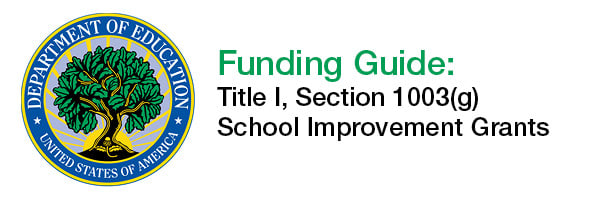Get the Funding You Need to Transform Your School for Success
 We have now summarized the qualifications for obtaining funding from four of the five U.S. DOE funds: Race to the Top, 21st Century Community Learning Centers, Charter Schools, and College and Career Readiness. If none of those funds is a good fit for your classrooms, consider the fifth fund: Title I, Section 1003(g), School Improvement Grants. If you meet its qualifications, you may be able to obtain funding for the technology your classrooms need.
We have now summarized the qualifications for obtaining funding from four of the five U.S. DOE funds: Race to the Top, 21st Century Community Learning Centers, Charter Schools, and College and Career Readiness. If none of those funds is a good fit for your classrooms, consider the fifth fund: Title I, Section 1003(g), School Improvement Grants. If you meet its qualifications, you may be able to obtain funding for the technology your classrooms need.
School Improvement Grants
The purpose of School Improvement Grants (SIG) is to provide adequate resources to substantially raise the achievement of students in the lowest-performing schools. The funds are granted to state educational agencies (SEAs), which use the money to make competitive sub-grants to local educational agencies (LEAs) that demonstrate the greatest need for the funds and the strongest commitment to use the funds appropriately.
Under Title I Part A, schools that do not meet goals for two years are designated “in need of improvement.” Schools that do not meet goals for three years are identified for “corrective action.” And schools that do not meet goals for four or more years qualify for “restructuring.” These schools are eligible for a School Improvement Grant (SIG).
SIG schools must select one of four models for school improvement.
- School Closure Model. Closure occurs when a school district closes a school and enrolls the students in other schools in the district that are higher achieving.
- Restart Model. Under this model, a local education agency (LEA) converts a school, or closes and reopens a school under a charter school operator, a charter management organization (CMO), or an education management organization (EMO) that has been selected through a rigorous review process.
- Turnaround Model. In this model, districts must replace the principal, rehire no more than 50% of the staff, and grant the new principal sufficient operational flexibility (including staffing, calendars/time, and budgeting) to fully implement a comprehensive approach to substantially improve student outcomes.
- Transformation Model. Districts must replace the principal and take steps to increase teacher and school leader effectiveness; institute comprehensive instructional reforms; increase learning time; create community-oriented schools; and provide operational flexibility and sustained support.
Key Requirements
The key requirements for this funding are as follows:
- Student Achievement. Raise student achievement.
- Efficacy. Program must be proven to raise student achievement. Scientifically based studies should be used.
- Technology-Based Supports. Use and integrate technology-based programs and interventions.
- Low-Performing Schools. Serve the lowest-performing schools.
- Use of Student Data. Promote the continuous use of student data. Use student data to inform and differentiate instruction.
- Professional Development. Funds may be reserved for ongoing and continuous professional development of staff.
o Elevating the quality of instruction.
o Providing substantial opportunities for professional development.
For more information about this fund, see http://www2.ed.gov/policy/elsec/leg/esea02/pg1.html.
Find Out How Interactive Technology Qualifies
To show you how Mimio technology ‒ hardware, software, or apps ‒ qualifies specifically for Title I, Section 1003(g) funds, we created a free guide that can make it possible for you to get the technology you want for your school or district. You can download it today. >>
Not sure that this is the fund for you?
There are four more guides in the series, each of which focuses on a single fund and how Mimio technology qualifies:
- Race to the Top
- 21st Century Community Learning Centers, Title IV, Part B
- Charter Schools
- Title I, Part A, College and Career Readiness
All guides are free and available for download. >>



